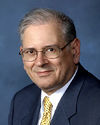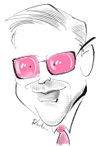Robert Kahn: Difference between revisions
| Line 21: | Line 21: | ||
* Fellow, [[ACM]]<ref>[http://fellows.acm.org/fellow_citation.cfm?id=4598637&srt=alpha&alpha=K ACM.org]</ref> | * Fellow, [[ACM]]<ref>[http://fellows.acm.org/fellow_citation.cfm?id=4598637&srt=alpha&alpha=K ACM.org]</ref> | ||
* Member, Board of Directors, [[Qualcomm]]<ref>[http://investor.qualcomm.com/directors.cfm Qualcomm.com]</ref> | * Member, Board of Directors, [[Qualcomm]]<ref>[http://investor.qualcomm.com/directors.cfm Qualcomm.com]</ref> | ||
* Member, [[NAE|National Academy of Engineering]] | |||
* Fellow, [[IEEE| Institute of Electrical and Electronics Engineers]] | |||
* Fellow, [[AAAI| Association for the Advancement of Artificial Intelligence]] | |||
* Fellow, Computer History Museum | |||
* Member, U.S. State Dept.'s Advisory Committee on International Communication and Information Policy | |||
* Former Member, President's Information Technology Advisory Committee | |||
* Former Member, Board of Regents of the National Library of Medicine | |||
* Former Member, President's Advisory Council on the National Information Infrastructure<ref>[http://www.cnri.reston.va.us/bios/kahn.html CNRI.reston.va.us]</ref> | |||
==Career History== | ==Career History== | ||
* Technical Engineer, Bell Laboratories | * Technical Engineer, Bell Laboratories | ||
Revision as of 23:20, 25 May 2011
 |
 |
| Country: | USA |
Robert E. Kahn is the co-inventor of the TCP/IP system that established the architectural basis of the Internet. He worked with Vinton Cerf to write the famous paper, "A Protocol for Packet Network Interconnection".[1]
Dr. Kahn is the Founder, Chairman, CEO, and President of the Corporation for National Research Initiatives.[2]
The Beginning
Dr. Kahn first met Dr. Cerf at U.C.L.A. in 1969, after the ARPANET nodes had been nationally distributed. At that time, he was working at an engineering firm in Cambridge, Mass., and travelled to U.C.L.A. to experiment with the new network.
By the time they published their famous paper, in 1973, Vinton was a professor at Stanford and Robert was working within the Defense Department's Advanced Research Projects Agency, the founders of the ARPAnet. They did not claim their protocols as intellectual property, and thus they were able to flourish as an open standard.[3]
Memberships
- Fellow, ACM[4]
- Member, Board of Directors, Qualcomm[5]
- Member, National Academy of Engineering
- Fellow, Institute of Electrical and Electronics Engineers
- Fellow, Association for the Advancement of Artificial Intelligence
- Fellow, Computer History Museum
- Member, U.S. State Dept.'s Advisory Committee on International Communication and Information Policy
- Former Member, President's Information Technology Advisory Committee
- Former Member, Board of Regents of the National Library of Medicine
- Former Member, President's Advisory Council on the National Information Infrastructure[6]
Career History
- Technical Engineer, Bell Laboratories
- Assistant Professor of Electrical Engineering, MIT
- Engineer, Bolt Beranek and Newman
- Director of Information Processing Techniques, DARPA
- Founder, Chairman, CEO and President, CNRI[7]
Awards
Robert, along with Vinton Cerf, recieved the 2004 ACM Turing Award. When they received the prize it was the first time in the 39 year history of the award that it was conferred in honor of work done on computer networking.
In 1997, Robert received the National Medal of Technology. That year he and Vinton also received the IEEE Alexander Graham Bell Medal.[8] He shared the 2001 Charles Stark Draper Prize with other important pioneers of the early Internet networking system.[9]
Education
- B.E.E, City College of NYC, 1960
- M.A., Princeton University, 1962
- Pd.D., Princeton University, 1964
